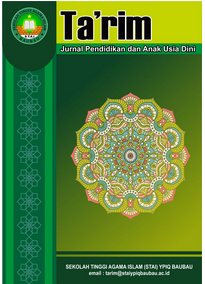Kedatangan Islam di Indonesia
DOI:
https://doi.org/10.59059/tarim.v5i1.947Keywords:
The Entry of Islam in Indonesia, the Development of Islam in Indonesia, the Role of Ulama and Sufis, DawaAbstract
Regarding the arrival of Islam in Indonesia, different perspectives emerge, influenced by the complexity of the phenomenon that Islam does not have a single origin in one place or a specific group. This diversity of theories is shaped by differences in historians' evidence, interests, religious subjectivities, and ideologies. Although the early arrival of Islam was concluded in 1963, research on the process of the arrival and development of Islam in Indonesia continues to develop, providing opportunities to refine or strengthen existing theories. Ulama (Islamic scholars) play a central role in the early arrival and development of Islam in Indonesia. Arab merchants, who were also Islamic scholars, formed the first group to propagate and develop Islam, followed by professional Sufi dais (religious leaders). The Sufi ulama figures are closely related to two main figures: the 4,444 traders who spread Islam through trade, the economic center of society, and the sultans, who spread Islam through authority. These features of the spread of Islam effectively contributed to the growth of Islam.The ulama developed Islam through three main channels: culture (preaching, educatin, art, culture, marriage), struture (politics and power), and economics (through trade routes). In other words, the Islaization process in Indonesia is influenced by political power and the spirit of da'wah. In this context, keywords such as the entry of Islam in Indonesia, the development of Islam in Indonesia, the role of ulama and Sufis, and da'wah are central points for understanding these power relations.
References
Abdullah, Taufik (Ed.). 1991. "Sejarah Umat Islam Indonesia." Majelis Ulama Indonesia, hlm. 39.
Hernti, E. 2017. "Islam dan Perkembangan Bahasa Melayu." Jurnal Lektur Keagamaan, 15(1), 81-96.
Husda, H. 2017. "Islamsasi Nusantara (Analisis Terhadap Discursus Para Sejarawan)." Jurnal Adabiya, 18(2), 17-29.
Ma’arif, Ahmad Syafi’I. 1988. "Islam Dan Politik Indonesia: Teori Belah Bambu Masa Demokrasi Terpimpin (1959-1965)." Yogyakarta: IAIN Sunan Kalijaga Press, hlm. 38-39.
Mubarak, F. 2021. "Pemikiran dan Peradaban Islam di Nusantara." OSF Preprints.
Siddiqi, Nourozaman. 1984. "Menguak Sejarah Muslim: Suatu Kritik Metodologis." Yogyakarta: PLP2M, hlm. 124.
Sunanto, Musyifah. 2010. "Sejarah Peradaban Islam Indonesia." Jakarta: Rajawali Pers, hlm. 39.
Downloads
Published
How to Cite
Issue
Section
License
Copyright (c) 2023 Ta'rim: Jurnal Pendidikan dan Anak Usia Dini

This work is licensed under a Creative Commons Attribution 4.0 International License.








